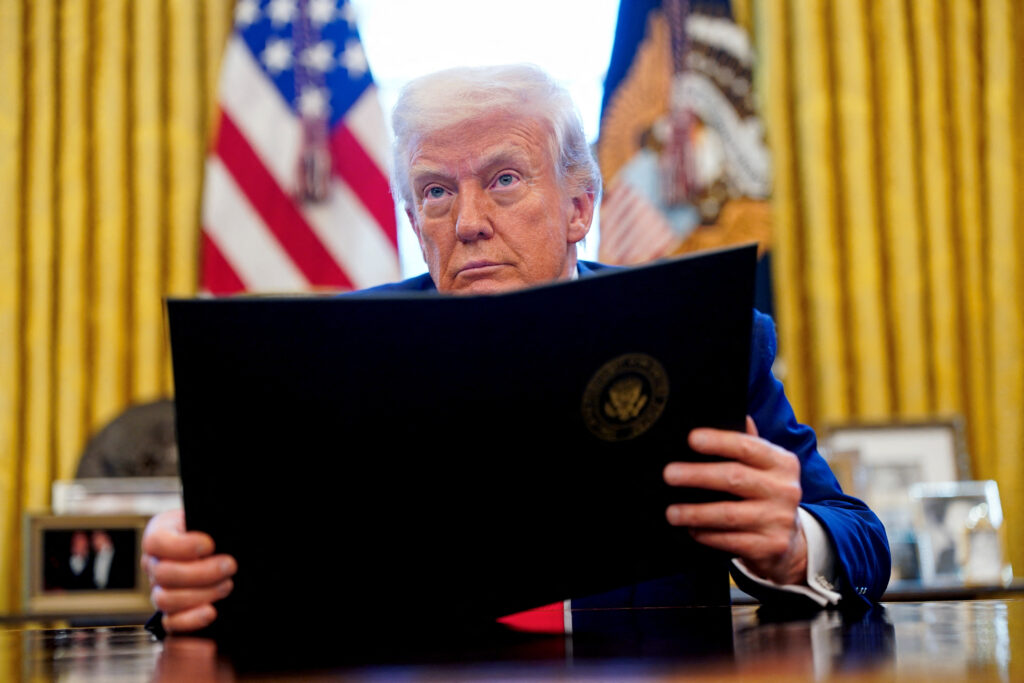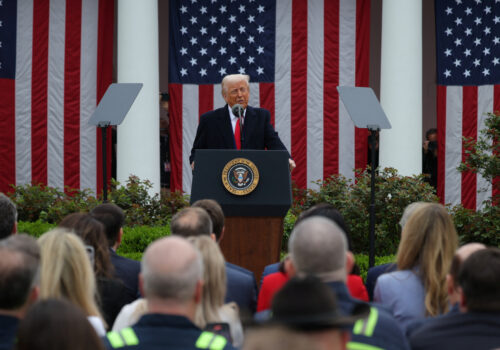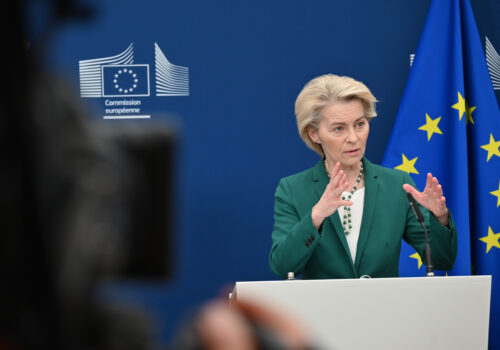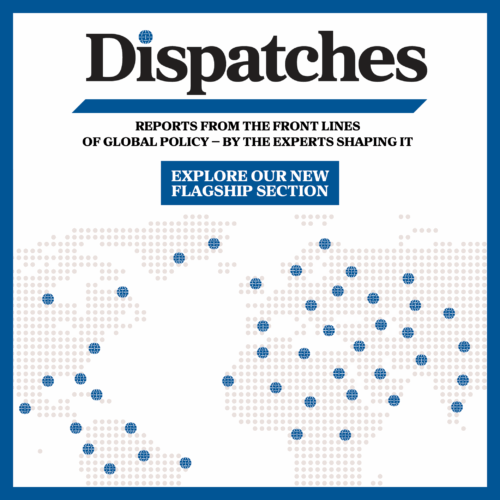GET UP TO SPEED
He’s hitting the brakes and the gas. On Wednesday, US President Donald Trump announced that he would suspend until July many of the “liberation day” import tariffs that had gone into effect hours earlier, but also raise the tariff on China to a whopping 145 percent—while keeping the 10 percent global tariff in place. The news caused markets to jolt upward, after having lost trillions of dollars in value in the past week, but they plunged again on Thursday as the full details became clear. Below our experts dig into what these changes mean for the global economy—and American consumers.
TODAY’S EXPERT REACTION BROUGHT TO YOU BY
- Josh Lipsky (@joshualipsky): Senior director of the Atlantic Council’s GeoEconomics Center and former adviser to the International Monetary Fund
- Barbara C. Matthews: Nonresident senior fellow at the GeoEconomics Center and former US Treasury attaché to the European Union
- L. Daniel Mullaney: Nonresident senior fellow with the Europe Center and GeoEconomics Center, and former assistant US trade representative
Bond bust
- While the US stock market has shed trillions of dollars in value since Trump announced the “reciprocal” tariffs on April 2, stocks did not move the US president to react. Instead, Josh tells us, “Trump saw the massive disruptions in the bond market and decided risking the entire US—and global—financial system was too high a price to pay for the reciprocal tariffs.”
- Rising bond yields and a falling US dollar were too alarming for Trump to ignore. “The president prioritized the reserve currency over a trade war waged using a particularly flawed calculation mechanism and rhetoric that inflamed anti-US sentiment even among the United States’ longest and most trusted allies,” says Barbara.
- While allies will feel at least temporary relief, it’s unlikely American consumers will, Josh concludes. The GeoEconomics Center team calculates that the overall tariff rate for the United States is nearly as high as it was before Trump’s Wednesday reversal because of the higher levy on China. “Trump launched a global trade war and then decided—at least for now—to zero in on China,” Josh says. “But don’t expect the rest of the world to rush to help the US given the whipsaw of the past week and tariffs they are facing. Remember: if Chinese goods can’t come into the US market, they’ll quickly flood other economies.”
Sign up to receive rapid insight in your inbox from Atlantic Council experts on global events as they unfold.
The next ninety
- “Expect US-China tensions to escalate before they de-escalate,” Josh predicts. “China has been preparing for this for six years. And while their economy is already struggling, they can handle the loss of revenue from these tariffs through a range of fiscal and currency maneuvers.”
- Meanwhile, other nations will likely feel pressure to choose between the United States and China, says Barbara. With some fifty governments apparently seeking to open bilateral negotiations with the United States, the next ninety days will launch the “technical, asymmetric negotiation phase” of the tariff war.
- Barbara is paying close attention to countries with upcoming elections, such as Australia and Canada: “Populist politics will incentivize those running for elective office to make promises regarding trade retaliation, but governing after the election may require immediate compromises.”
- We will also see a flurry of attempted dealmaking at the IMF-World Bank Spring Meetings in Washington in ten days. “Expect economies like Japan and India to move to the front of the line while the European Union likely will have to wait, given the president’s long-standing complaints about the single market” Josh tells us.
Post-pause predictions
- So what’s Brussels’s next move? Barbara argues that “if the EU were to take a stronger stance regarding China” in the coming months, it could become a model for many countries in this attempted global trade rebalancing. “The most optimistic scenario here would see the EU emerge publicly as an equal partner to the United States in the geoeconomic battle against China.”
- But it’s unclear where that US-China battle is heading. Josh interprets Wednesday’s market surge as investor optimism about a deal between the world’s two largest economies, given Trump’s willingness to back off in this instance. “But just like the original market bet that Trump would only be in negotiating mode, that hope may be misplaced.”
- Josh also points to the newly created massive tariff imbalance in Asia raising the “trans-shipment risk” that cropped up during Trump’s first term, when Chinese goods were rerouted to the United States via lower-tariff countries. Vietnam and Malaysia are well positioned to benefit this time, he adds.
- More advanced economies in the Pacific region such as Australia and India will also experience increased trade pressures from expected forthcoming US trade measures on pharmaceuticals. Barbara observes that “trade diversification solutions that prioritize Europe at the expense of China could be viewed as a positive outcome by the White House if they are accompanied by concessions to the United States regarding non tariff barriers.”
- Amid a “head-spinning” week, Dan advises to pay attention to the Trump administration’s underlying consistency: “Tariffs are primarily a tool to achieve specific objectives, among them to counter perceived imbalances in the trading system,” says Dan, and the Trump administration has laid now out those objectives in detail.
- Since tariffs can often be a “blunt tool that inflicts self harm,” Dan says, it would make sense to seek “alternate arrangements in lieu of tariffs that achieve the objectives, without the adverse consequences.” What’s needed now, he argues, are “calm discussions over trade and investment packages and initiatives that address the underlying concerns.”
Further reading
Tue, Apr 8, 2025
No one is coming to save the global economy
New Atlanticist By Josh Lipsky
Neither the Group of Twenty nor the Federal Reserve should be expected to use their playbook from previous economic crises to respond to economic shocks caused by US tariffs.
Fri, Apr 4, 2025
Experts react: How the world is responding to Trump’s ‘liberation day’ tariffs
New Atlanticist By
Atlantic Council experts tour the world to take stock of how US trading partners are responding to US President Donald Trump’s new reciprocal tariffs.
Tue, Apr 8, 2025
The EU could respond to Trump’s tariffs with a new ‘anti-coercion instrument.’ Here’s what to know.
New Atlanticist By
Confronted with the latest round of US tariffs, the European Union is considering a new but untested tool in its economic-security toolbox.
Image: US President Donald Trump looks on, as he signs executive orders and proclamations in the Oval Office at the White House in Washington, D.C., U.S., April 9, 2025. REUTERS/Nathan Howard




